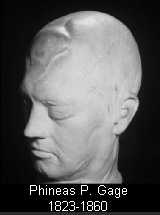
Phineas Gage
Overview
Phineas P. Gage
was an American railroad construction foreman now remembered for his improbable
survival of an accident in which a large iron rod was driven completely through his head, destroying much of his brain's left frontal lobe
, and for that injury's reported effects on his personality and behavior – effects so profound that friends saw him as "no longer Gage".
Long called "the American Crowbar Case" – once termed "the case which more than all others is calculated to excite our wonder, impair the value of prognosis, and even to subvert our physiological
doctrines" – Phineas Gage influenced 19th-century discussion about the brain, particularly debate on cerebral localization, and was perhaps the first case suggesting that damage to specific regions of the brain might affect personality and behavior.
Gage is a fixture in the curricula of neurology
, psychology
and related disciplines, and is frequently mentioned in books and academic papers; he also has a minor place in popular culture. LeUnes' survey found Harlow (1868) to be the second most frequently cited work in twentieth-century psychology texts; see also Macmillan (2000) ch.
was an American railroad construction foreman now remembered for his improbable
survival of an accident in which a large iron rod was driven completely through his head, destroying much of his brain's left frontal lobe
Frontal lobe
The frontal lobe is an area in the brain of humans and other mammals, located at the front of each cerebral hemisphere and positioned anterior to the parietal lobe and superior and anterior to the temporal lobes...
, and for that injury's reported effects on his personality and behavior – effects so profound that friends saw him as "no longer Gage".
Long called "the American Crowbar Case" – once termed "the case which more than all others is calculated to excite our wonder, impair the value of prognosis, and even to subvert our physiological
Physiology
Physiology is the science of the function of living systems. This includes how organisms, organ systems, organs, cells, and bio-molecules carry out the chemical or physical functions that exist in a living system. The highest honor awarded in physiology is the Nobel Prize in Physiology or...
doctrines" – Phineas Gage influenced 19th-century discussion about the brain, particularly debate on cerebral localization, and was perhaps the first case suggesting that damage to specific regions of the brain might affect personality and behavior.
Gage is a fixture in the curricula of neurology
Neurology
Neurology is a medical specialty dealing with disorders of the nervous system. Specifically, it deals with the diagnosis and treatment of all categories of disease involving the central, peripheral, and autonomic nervous systems, including their coverings, blood vessels, and all effector tissue,...
, psychology
Psychology
Psychology is the study of the mind and behavior. Its immediate goal is to understand individuals and groups by both establishing general principles and researching specific cases. For many, the ultimate goal of psychology is to benefit society...
and related disciplines, and is frequently mentioned in books and academic papers; he also has a minor place in popular culture. LeUnes' survey found Harlow (1868) to be the second most frequently cited work in twentieth-century psychology texts; see also Macmillan (2000) ch.

